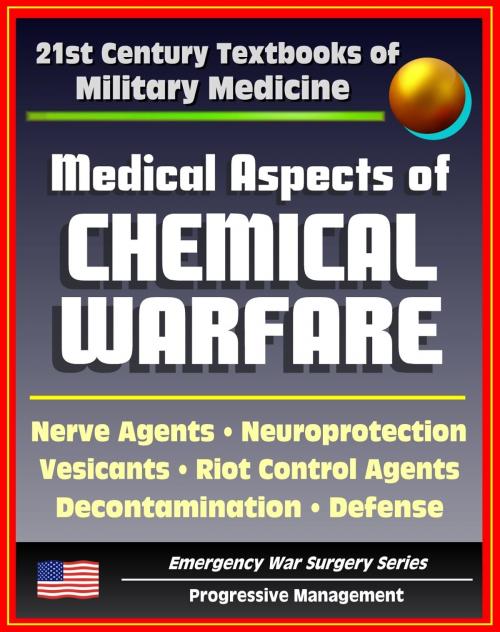21st Century Textbooks of Military Medicine - Medical Aspects of Chemical Warfare - Nerve Agents, Incapacitating Agents, Riot Control, Toxins, Defense, Decontamination (Emergency War Surgery Series)
Nonfiction, Health & Well Being, Medical, Reference, Social & Cultural Studies, Political Science| Author: | Progressive Management | ISBN: | 9781465856777 |
| Publisher: | Progressive Management | Publication: | August 2, 2011 |
| Imprint: | Smashwords Edition | Language: | English |
| Author: | Progressive Management |
| ISBN: | 9781465856777 |
| Publisher: | Progressive Management |
| Publication: | August 2, 2011 |
| Imprint: | Smashwords Edition |
| Language: | English |
From the much-referenced and highly acclaimed Textbooks of Military Medicine series, the massive, twelve-hundred page Medical Aspects of Chemical Warfare textbook is a comprehensive source of the information available on chemical agents, including detailed explanations of chemical detectors and protection equipment, methods of diagnosis, decontamination techniques, established and emerging countermeasures and therapy techniques, and response planning, as well as the history of chemical warfare and casualty management. This book will increase the level of preparedness and response capability of military and civilian practitioners responsible for chemical casualty care. Lieutenant General Eric B. Schoomaker, Surgeon General of the US Army, calls the text “strongly recommended reading for all military medical personnel. . . . Many civilian medical professionals will also find this textbook to be a valuable reference as their hospitals prepare for the possibility of treating casualties of an accidental or deliberate exposure.” Written by a team of both military and civilian experts led by the US Army Medical Research Institute of Chemical Defense at Aberdeen, Maryland, the book includes cutting-edge science that has emerged since the first edition to significantly expand diagnostic and therapeutic techniques. The book will provide the medical force with the latest information to help them understand and identify the chemical threat; to plan for response; to protect soldiers, the public, and responders; and to deliver the highest quality of casualty care. Conceived in 1987, the Borden Institute, under the Army Surgeon General, publishes the Textbooks of Military Medicine. Each book is a comprehensive subject reference on the art and science of military medicine, extensively illustrated, and written to integrate lessons learned in past wars with current principles and practices of military medicine.
Reflecting the critical threat posed by chemical warfare and terrorism, this 2008 book completes the update of Borden’s 1997 Medical Aspects of Chemical and Biological Warfare. Since then, an increasing “concern for the United States and its allies is that an ever-growing number of terrorist organizations will employ chemical warfare agents in an attack on military forces or civilians.
Topics covered include: History; Nerve Agents; Neuroprotection Treatment; Bioscavengers; Vesicants; Long Term Health Effects of Chemical Agents; Toxic Inhalational Injury and Toxic Industrial Chemicals; Cyanide; Incapacitating Agents; Riot Control Agents; Field Management of Chemical Casualties; Triage of Chemical Casualties; Decontamination; Chemical Defense Equipment; Occupational Health; Toxins; Medical Chemical Defense Acquisition Programs; Medical Management Chemical Toxicity in Pediatrics; Medical Diagnostics; Domestic Preparedness.
The opening chapters provide a thorough and compelling history of chemical warfare, with on-scene accounts of the horrors inflicted by these fearsome weapons. These chapters offer great depth concerning the history of chemical warfare and the basic principles of chemical warfare. "History of Chemical Warfare" takes a broad view of the historical context and significant events in the field. "History of the Chemical Threat" breaks the 20th century down into decade-long segments and provides a fresh perspective on prior military and political developments. "The Medical Aspects of Medical Management" chapter has radically changed over the years and presents this history from multiple perspectives.
This is a privately authored news service and educational publication of Progressive Management. For over a quarter of a century, our news, educational, technical, scientific, and medical publications have made unique and valuable references accessible to all people. Our e-books put knowledge at your fingertips, and an expert in your pocket!
From the much-referenced and highly acclaimed Textbooks of Military Medicine series, the massive, twelve-hundred page Medical Aspects of Chemical Warfare textbook is a comprehensive source of the information available on chemical agents, including detailed explanations of chemical detectors and protection equipment, methods of diagnosis, decontamination techniques, established and emerging countermeasures and therapy techniques, and response planning, as well as the history of chemical warfare and casualty management. This book will increase the level of preparedness and response capability of military and civilian practitioners responsible for chemical casualty care. Lieutenant General Eric B. Schoomaker, Surgeon General of the US Army, calls the text “strongly recommended reading for all military medical personnel. . . . Many civilian medical professionals will also find this textbook to be a valuable reference as their hospitals prepare for the possibility of treating casualties of an accidental or deliberate exposure.” Written by a team of both military and civilian experts led by the US Army Medical Research Institute of Chemical Defense at Aberdeen, Maryland, the book includes cutting-edge science that has emerged since the first edition to significantly expand diagnostic and therapeutic techniques. The book will provide the medical force with the latest information to help them understand and identify the chemical threat; to plan for response; to protect soldiers, the public, and responders; and to deliver the highest quality of casualty care. Conceived in 1987, the Borden Institute, under the Army Surgeon General, publishes the Textbooks of Military Medicine. Each book is a comprehensive subject reference on the art and science of military medicine, extensively illustrated, and written to integrate lessons learned in past wars with current principles and practices of military medicine.
Reflecting the critical threat posed by chemical warfare and terrorism, this 2008 book completes the update of Borden’s 1997 Medical Aspects of Chemical and Biological Warfare. Since then, an increasing “concern for the United States and its allies is that an ever-growing number of terrorist organizations will employ chemical warfare agents in an attack on military forces or civilians.
Topics covered include: History; Nerve Agents; Neuroprotection Treatment; Bioscavengers; Vesicants; Long Term Health Effects of Chemical Agents; Toxic Inhalational Injury and Toxic Industrial Chemicals; Cyanide; Incapacitating Agents; Riot Control Agents; Field Management of Chemical Casualties; Triage of Chemical Casualties; Decontamination; Chemical Defense Equipment; Occupational Health; Toxins; Medical Chemical Defense Acquisition Programs; Medical Management Chemical Toxicity in Pediatrics; Medical Diagnostics; Domestic Preparedness.
The opening chapters provide a thorough and compelling history of chemical warfare, with on-scene accounts of the horrors inflicted by these fearsome weapons. These chapters offer great depth concerning the history of chemical warfare and the basic principles of chemical warfare. "History of Chemical Warfare" takes a broad view of the historical context and significant events in the field. "History of the Chemical Threat" breaks the 20th century down into decade-long segments and provides a fresh perspective on prior military and political developments. "The Medical Aspects of Medical Management" chapter has radically changed over the years and presents this history from multiple perspectives.
This is a privately authored news service and educational publication of Progressive Management. For over a quarter of a century, our news, educational, technical, scientific, and medical publications have made unique and valuable references accessible to all people. Our e-books put knowledge at your fingertips, and an expert in your pocket!















